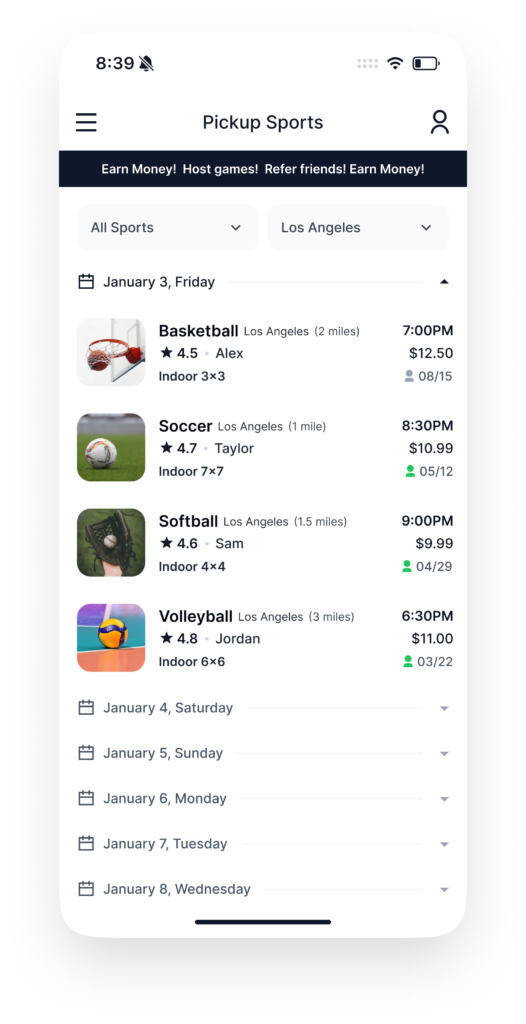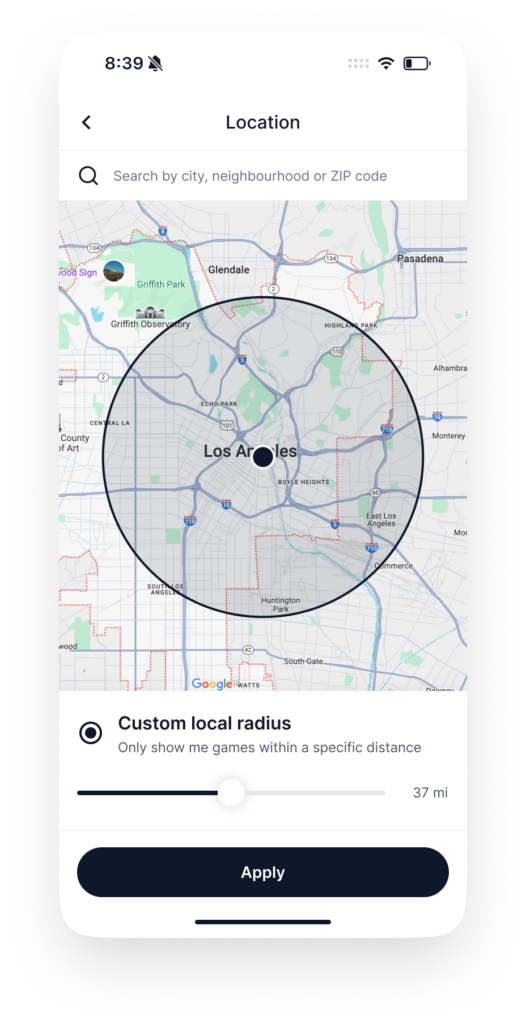Knee Pain from Pickleball: Understanding, Preventing, and Managing Injuries
Pickleball has swiftly become one of the most popular recreational sports among adults, offering an exhilarating way to stay active and socialize. However, with its rapid rise in popularity comes a common issue – knee pain. If you’ve been searching for “knee pain from pickleball,” you’re not alone. This post will explore the causes of knee pain, strategies for prevention and management, and how the Pickup Sports App can help you find the right leagues or matches to play safely and effectively.
Understanding Knee Pain in Pickleball Players
Knee pain can arise from various factors, particularly for players who engage in sports involving sudden movements like pickleball. The sport requires quick lateral movements, rapid acceleration and deceleration, and frequent changes in direction. These actions can strain the knees, leading to injuries such as:
1. Patellar Tendonitis: Also known as “jumper’s knee,” this occurs when the tendon connecting the kneecap to the shinbone becomes inflamed. It’s commonly seen in athletes, especially in sports featuring jumping and fast stops.
2. Meniscus Tears: The meniscus acts as a cushion between your shinbone and thighbone. Twisting your knee forcefully could lead to a tear, causing pain and swelling.
3. Ligament Injuries: The anterior cruciate ligament (ACL) and medial collateral ligament (MCL) are particularly vulnerable during the quick, lateral movements typical in pickleball.
4. Patellofemoral Pain Syndrome: Often referred to as “runner’s knee,” this condition causes pain around the kneecap, often exacerbated by activities involving repetitive knee bending.
5. Osteoarthritis: While not exclusive to pickleball, repetitive stress on the knees can contribute to the wear and tear associated with osteoarthritis, which can be particularly painful for older players.
Recognizing Symptoms of Knee Pain
Pay attention to the following symptoms that could indicate knee pain due to pickleball activities:
Swelling or Inflammation: Noticeable swelling around the knee.
Pain During Activity: Sharp or dull pain in the knee during or post-game.
Limited Range of Motion: Difficulty bending or straightening the knee.
Creaking or Popping Sensations: Unusual sounds in the knee during movement.
If you experience any of these symptoms, it’s essential to seek professional advice or treatment to prevent further damage.
Common Causes of Knee Pain in Pickleball
Understanding why knee pain occurs can help players make better decisions concerning their health and gameplay. Some common causes include:
1. Poor Footwear
Worn-out shoes or inappropriate footwear can lead to improper alignment and increased stress on the knees. Invest in supportive, specialized athletic shoes designed for pickleball to ensure proper posture and stability.
2. Overuse
Like any sport, excessive play can result in overuse injuries. Players who frequently engage in games without proper rest or recovery may find themselves susceptible to knee pain.
3. Lack of Conditioning
Pickleball involves quick movements that require strong muscles and ligaments. If your muscles are not adequately conditioned to handle these sudden demands, it can result in knee strain.
4. Inadequate Warm-Up and Cool Down
Jumping right into games without warming up can increase the likelihood of injury. A comprehensive warm-up and cool-down routine focusing on dynamic stretching and muscle relaxation can greatly reduce knee pain risk.
Preventing Knee Pain While Playing Pickleball
While knee pain can be a concern, there are several steps players can take to minimize the risk of injury:
1. Invest in Quality Footwear
Choosing the right shoes can provide the support necessary to keep your knees healthy. Look for shoes with good cushioning and stability and ensure they’re suited to the demands of pickleball.
2. Strength Training
Incorporate strength training into your routine to build the muscles supporting your knees. Focus on quadriceps, hamstrings, and calves for overall knee stability.
3. Flexibility Exercises
Stretching exercises can improve flexibility and help prevent injury. Include stretches that target the knee area and surrounding muscle groups before and after matches.
4. Warm-Up and Cool Down
Dedicate time to warming up before starting to play and cooling down afterward. Dynamic stretching is recommended to increase blood flow to the muscles, while static stretching post-game helps alleviate muscle tightness.
5. Listen to Your Body
If you experience pain, don’t push through it. Take a break, rest, and assess your situation. Ignoring pain can lead to more severe injuries down the line.
Managing Knee Pain When It Occurs
If you do experience knee pain while playing pickleball, here are some strategies to manage it effectively:
1. RICE Method
Use the RICE method (Rest, Ice, Compression, Elevation) immediately after an injury to reduce swelling and alleviate pain.
2. Physical Therapy
Consult with a physical therapist who can assess your knee health and develop a personalized rehabilitation program to strengthen your knees and improve mobility.
3. Anti-inflammatory Medications
Over-the-counter medications, such as ibuprofen or naproxen, can help reduce inflammation and pain. However, consult with a healthcare professional for appropriate dosages and usage.
4. Corticosteroid Injections
For more severe pain, a doctor may recommend corticosteroid injections to alleviate inflammation. However, this should be considered after other treatment options.
5. Gradual Return to Play
Once you’re feeling better, ease back into playing pickleball gradually. Start with less intense sessions before resuming regular play.
The Role of the Pickup Sports App
In your quest for fitness and socialization through sports like pickleball, the Pickup Sports App is a fantastic resource. Here’s how it can be particularly beneficial for players dealing with knee pain or looking to prevent injuries:
1. Find Suitable Leagues and Matches
The Pickup Sports App allows you to discover adult sports leagues in your city that suit your skill level. This can ease the pressure of finding a game and give you the chance to play in an environment that matches your current condition.
2. Access to Community and Resources
Join communities of local players who understand the common challenges and can share tips and advice on managing knee pain related to pickleball. Learning from others is crucial to improving your skills and health.
3. Schedule Wisely
Use the app to schedule games when your body feels at its best. The flexibility to choose your time helps you avoid overexertion and potential injuries.
4. Participate in Recreational Play
The Pickup Sports App can connect you with recreational play focused on fun and socialization rather than competition. Slower-paced games can ease your knees while still keeping you active.
5. Stay Updated on Local Workshops and Events
Many local leagues or health organizations offer workshops on athletic health, including knee care strategies. Use the app to stay informed and take advantage of these valuable resources.
Conclusion
Knee pain can be a significant concern for pickleball players; however, understanding the causes and implementing preventative measures can make a world of difference. By investing in quality footwear, maintaining strength and flexibility, and using proper warm-up and cool-down techniques, you can minimize your risk of injury.
If you’re seeking adult sports leagues in your area or looking for tips on engaging in pickleball safely, the Pickup Sports App can be your ally. With its resources, community, and flexibility, you can find the right matches that keep the game fun while prioritizing your health.
Incorporate these strategies into your pickleball routine, listen to your body, and enjoy the exciting sport that brings many pleasures to its players while ensuring your knees remain healthy. Let’s get back on the court—safely!
—–
By targeting the search term “knee pain from pickleball,” discussing appropriate preventive measures and treatment methods, and introducing the Pickup Sports App as a beneficial tool, this blog post provides a comprehensive and relevant resource for potential readers.





